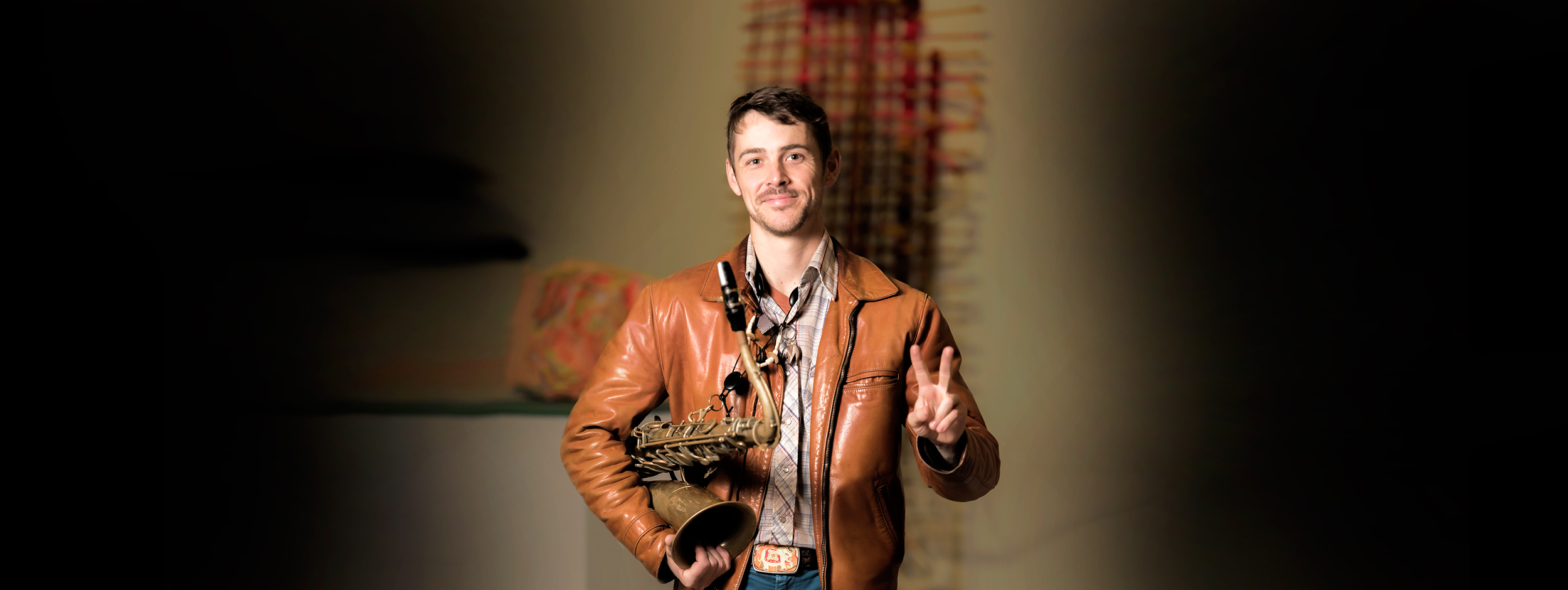Creating Your Own World Through Unaccompanied Performance: Part 2
with Patrick Breiner
Date Posted: July 12, 2017

Phone interview conducted by John R. Hylkema
How do you approach pacing in unaccompanied music?
Patrick Breiner: A lot of it is dictated by my physical ability to actually perform something for a certain amount of time. For instance, with a lot of the circular breathing and repetitive types of things that I play, I will physically play them for as long as I can. My practicing is built around building the physical stamina and strength to keep an idea going long enough for it to blossom, grow, and deepen. It’s almost something that’s hard to talk about because I almost exclusively play my own compositions. I’m not learning solo saxophone music written by other people. I’ve always built my own repertoire myself which is somewhat based on my strengths but also largely based on my weaknesses. For instance, if I have been spending a lot of time on circular breathing or playing a piece where I don’t stop for 10 or 15 minutes, then I’m aware that’s an available piece of my repertoire.
So how do I balance that? Perhaps I can challenge myself to compose something with a lot more space in it rather than space being more of an afterthought. A lot of it is the pacing and a lot of it just has to do with what my available repertoire is. If I’m preparing for a solo performance and I’m looking at my repertoire and feel like I have a lot of things that sound or feel the same to me, then that is absolutely going to lead me to compose and prepare something on the opposite end of the spectrum.
How do you keep your audience engaged in unaccompanied saxophone music?
I think a little bit about the audience but mostly I’m concentrating on composing music that interests me. (Chuckling) Trying to imagine an audience that would want something specific from a solo saxophone performance kind of cracks me up because I can’t really imagine an audience that would want to hear a solo saxophone performance. In that way it’s very much a self-serving practice. I think the thing that I’m striving for is just the rawest and truest sound along with the things that I find not only to be the most interesting, but the things that affect me most deeply on an emotional level. A lot of the time while I’m searching for that, I often find things that are quite difficult to play. I think focusing on the truest sound I could imagine and the material that moves me the most as well as something that is physically and mentally challenging to perform is going to translate to the audience. If it’s clear that I’m working really hard, the audience is going to respond to that. If it’s clear that I’m reaching for something that’s beyond my grasp I think that will also be clear to the audience. That’s something, as an audience member, I find really fascinating. Watching a performer push themselves to a point where they say, “Ya know what? This might not work.” That I find really interesting. That vulnerability helps me as an audience member relate to the performer. That’s a place that I strive for.
Why should someone program an unaccompanied piece on a recital?
My experience performing solo is based largely around creating a whole set worth of music, which sometimes is 20 minutes and other times is 60 minutes. For me, it feels more consistent to develop a sound world and language in which not only I can exist, but my audience can exist, too. So they’re not learning to listen to a jazz trio and then immediately learning to listen to a solo saxophone piece and then learning to listen to a duet with a pianist. I think there’s something really deep and beautiful about taking the audience on a really specific journey and, as you’re learning to communicate with that specific group of people, they’re also learning to listen to you. Every new listening experience we have is a learning experience.
What project(s) are you currently working on?
I’ve been playing a lot and touring a bit with Battle Trance. There are a few recordings that I’m mixing in the next couple of weeks; one of which is a duo with a great drummer and friend of mine named Max Goldman. We're called Pride of Lowell. There’s another project with my friend Nathan Pape who’s a great guitar player, who’s also a math teacher here in Brooklyn. We recorded something in July and we’re going to mix that soon. I've also been sitting on a recording of Double Double, my band with drums and 2 bass players, for about a year and a half.
I have been working on some new solo-not just repertoire-but some new vocabulary, for me, which has been a real challenge. I’m really interested in releasing an art book that has a download code for the music. There’s a band that I played with a little bit with another saxophonist named David Crowell and an electronic sound artist named Tyler Gilmore. We put out something under the name Very Feeling on my label Sulde. It’s basically an EP length release accompanied by a 5 page miniature sci-fi saga that I wrote. Each page has kind of a miniature poem that was inspired by the music on one side and art on the other side. My friend Connie Wang, who makes the art for all my recordings, made these beautiful panels that were inspired by the words and the music and then screen printed everything by hand. So it’s a 5 page book of words and art along with a download code. Hopefully in the next year or so I can release some more work in that format, but we’ll see what happens.